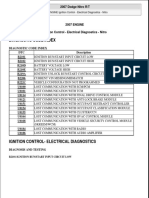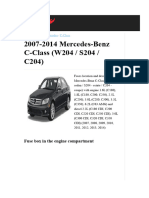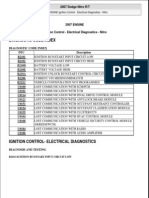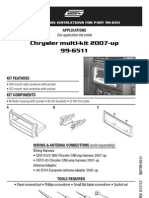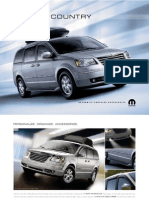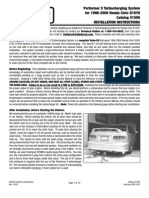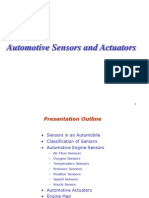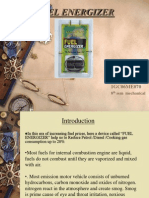Dogde Nitro 2007 Exhaust and Turbo
Dogde Nitro 2007 Exhaust and Turbo
Uploaded by
Murat SahitiCopyright:
Available Formats
Dogde Nitro 2007 Exhaust and Turbo
Dogde Nitro 2007 Exhaust and Turbo
Uploaded by
Murat SahitiOriginal Description:
Copyright
Available Formats
Share this document
Did you find this document useful?
Is this content inappropriate?
Copyright:
Available Formats
Dogde Nitro 2007 Exhaust and Turbo
Dogde Nitro 2007 Exhaust and Turbo
Uploaded by
Murat SahitiCopyright:
Available Formats
2007 Dodge Nitro R/T
2007 ENGINE Exhaust System And Turbocharger - Nitro
2007 ENGINE Exhaust System And Turbocharger - Nitro
DESCRIPTION
DESCRIPTION-GAS ENGINE
Fig. 1: Exhaust System - Gas Courtesy of CHRYSLER LLC 1 - EXHAUST FLANGE 2 - CATALYTIC CONVERTER 3 - FRONT EXHAUST PIPE ASSEMBLY-TO-MUFFLER CLAMP 4 - MUFFLER 5 - INSULATOR 6 - RESONATOR The basic exhaust system consists of an exhaust pipe assembly with catalytic converters (2), muffler (4) and tailpipe assembly and heat shields The exhaust system must be properly aligned to prevent stress, leakage and body contact. Minimum clearance between any exhaust component and the body or frame is 25 mm (1.0 in.). If the system contacts any body panel, it may amplify objectionable noises from the engine or body. When inspecting an exhaust system, critically inspect for cracked or loose joints, stripped screw or bolt threads, corrosion damage and worn, cracked or broken hangers. Replace all components that are badly corroded or damaged. DO NOT attempt to repair. When replacement is required, use original equipment parts (or equivalent). This will assure proper engine
2007 Dodge Nitro R/T
2007 ENGINE Exhaust System And Turbocharger - Nitro
function and system alignment. CAUTION: Avoid application of rust prevention compounds or undercoating materials to exhaust system floor pan exhaust heat shields. Light overspray near the edges is permitted. Application of coating will result in excessive floor pan temperatures and objectionable fumes. DESCRIPTION-2.8L DIESEL
Fig. 2: Exhaust System - 2.8L Diesel - W/Out DPF Courtesy of CHRYSLER LLC 1 - OXYGEN SENSOR 2 - MANIVERTER 3 - MANIVERTER TO EXHAUST PIPE FLANGE 4 - FLEXIBLE BELLOWS 5 - ISOLATORS 6 - MUFFLER/TAILPIPE ASSEMBLY 7 - EXHAUST PIPE TO MUFFLER FLANGE CAUTION: Avoid application of rust prevention compounds or undercoating materials to exhaust system floor pan exhaust heat shields. Light overspray near the edges is permitted. Application of coating will result in excessive floor pan temperatures and objectionable fumes. The diesel engine exhaust system consists of an engine exhaust manifold, turbocharger, EGR valve with intercooler, front exhaust pipe with catalytic converter, muffler and tailpipe assembly.
2007 Dodge Nitro R/T
2007 ENGINE Exhaust System And Turbocharger - Nitro
Fig. 3: Exhaust System - 2.8L Diesel - W/DPF Courtesy of CHRYSLER LLC 1 - MANIVERTER 2 - MANIVERTER TO DFP FLANGE 3 - PRESSURE SENSOR TUBING 4 - STEADY MOUNT 5 - FLEXIBLE BELLOWS 6 - ISOLATOR 7 - MUFFLER/TAIL PIPE ASSEMBLY 8 - DPF TO MUFFLER FLANGE The exhaust system must be properly aligned to prevent stress, leakage and body contact. The exhaust components should be kept a minimum of 25.4 mm (1.0 in.) away from the body and frame. If the system contacts any body panel, it may amplify objectionable noises from the engine or body.
DIAGNOSIS AND TESTING
EXHAUST SYSTEM-GAS ENGINES CONDITION POSSIBLE CAUSE EXCESSIVE EXHAUST NOISE 1. Leaks at pipe joints. OR LEAKING EXHAUST GASES 2. Rusted or blown out muffler. 3. Broken or rusted out exhaust pipe. 4. Exhaust pipe leaking at manifold flange. CORRECTION 1. Tighten clamps/bolts to specified torque at leaking joints. 2. Replace muffler. Inspect exhaust system. 3. Replace exhaust pipe. 4. Tighten/replace flange attaching nuts/bolts.
2007 Dodge Nitro R/T
2007 ENGINE Exhaust System And Turbocharger - Nitro
5. Exhaust manifold cracked or broken. 6. Leak between exhaust manifold and cylinder head. 7. Catalytic converter rusted or blown out. 8. Restriction in exhaust system.
5. Replace exhaust manifold. 6. Tighten exhaust manifold to cylinder head bolts. 7. Replace catalytic converter assy. 8. Remove restriction, if possible. Replace restricted part if necessary.
CAUTION: When servicing and replacing exhaust system components, disconnect the oxygen sensor connector(s). Allowing the exhaust to hang by the oxygen sensor wires will damage the harness and/or sensor.
EXHAUST SYSTEM-DIESEL ENGINE CAUTION: On high mileage vehicles it is normal to see some exhaust staining around the turbocharger control rod area. This is not a sign of turbocharger failure. EXHAUST SYSTEM DIAGNOSIS CHART CONDITION POSSIBLE CAUSE EXCESSIVE EXHAUST NOISE 1. Leaks at pipe joints. OR LEAKING EXHAUST GASES 2. Rusted or blown out muffler. 3. Broken or rusted out exhaust pipe. 4. Exhaust pipe leaking at manifold flange. 5. Exhaust manifold cracked or broken. 6. Leak between exhaust manifold and cylinder head.
CORRECTION 1. Tighten clamps/bolts at leaking joints. 2. Replace muffler. Inspect exhaust system. 3. Replace exhaust pipe. 4. Tighten/replace flange attaching nuts/bolts. 5. Replace exhaust manifold.
Driveability Concern - Turbo
6. Tighten exhaust manifold to cylinder head bolts. Replace gasket if necessary. 7. Turbocharger mounting flange 7. Remove turbocharger and cracked. inspect. (Refer to REMOVAL ). 8. Restriction in exhaust system. 8. Remove restriction, if possible. Replace restricted part if necessary. 9. EGR pipe(s) leak. 9. Tighten bolts. Replace gasket. 10. EGR assembly leak. 10. Tighten bolts. Replace gaskets. 1. Vacuum hose disconnected. 1. Check connections, replace as necessary. 2. Vacuum system leaks. 2. Inspect for damage. Check for
2007 Dodge Nitro R/T
2007 ENGINE Exhaust System And Turbocharger - Nitro
3. Boost pressure solenoid filter clogged.
leaks, replace as necessary. 3. Replace the filter.
SPECIFICATIONS
TORQUE SPECIFICATIONS TORQUE SPECIFICATIONS DESCRIPTION EGR Pipe to EGR Inlet Front Exhaust Pipe Flange-to-Exhaust Manifold Bolts Front Exhaust pipe-toMuffler Flange Nuts Turbocharger Support Bracket Bolts Turbocharger Downpipe Nuts Turbocharger Oil Supply Line Fitting Turbocharger Oil Return Line bolts Turbocharger to Exhaust Manifold Nuts
N.m 32 36
Ft. Lbs. 24 28
In. Lbs. -
36 24 32 24 11 32
28 18 24 18 24
215 96 -
SPECIAL TOOLS
SPECIAL TOOLS
Fig. 4: Turbocharger Tester 9022 Courtesy of CHRYSLER LLC
2007 Dodge Nitro R/T
2007 ENGINE Exhaust System And Turbocharger - Nitro
Fig. 5: Adaptor 8442 Courtesy of CHRYSLER LLC
CONVERTER-CATALYTIC
DESCRIPTION
DESCRIPTION
WARNING: The normal operating temperature of the exhaust system is very high. Therefore, never work around or attempt to service any part of the exhaust system until it is cooled. Special care should be taken when working near the catalytic converter. The temperature of the converter rises to a high level after a short period of engine operation time. CAUTION: DO NOT remove spark plug wires from plugs or by any other means short out cylinders. Failure of the catalytic converter can occur due to a temperature increase caused by unburned fuel passing through the converter. The stainless steel catalytic converter body is designed to last the life of the vehicle. Excessive heat can result in bulging or other distortion, but excessive heat will not be the fault of the converter. If unburned fuel enters the converter, overheating may occur. If a converter is heat-damaged, correct the cause of the damage at the same time the converter is replaced. Also, inspect all other components of the exhaust system for heat damage. Unleaded gasoline must be used to avoid contaminating the catalyst core. 50 State emission vehicles incorporate two catalytic converters located after the exhaust manifolds and before the muffler. REMOVAL
2007 Dodge Nitro R/T
2007 ENGINE Exhaust System And Turbocharger - Nitro
REMOVAL-3.7L ENGINE
Fig. 6: 3.7L Catalytic Converter Courtesy of CHRYSLER LLC WARNING: If torches are used when working on the exhaust system, do not allow the flame near the fuel lines. 1. 2. 3. 4. Raise and support the vehicle. Saturate the bolts (1) and nuts with heat valve lubricant. Allow 5 minutes for penetration. Disconnect oxygen sensor electrical connectors. Remove the nuts from the front exhaust pipe and catalytic converter assembly to muffler flange.
2007 Dodge Nitro R/T
2007 ENGINE Exhaust System And Turbocharger - Nitro
5. Remove bolts (1) and flanged nuts at the manifold. 6. Lower the front exhaust pipe/catalytic converter assembly (3) and slide out of the mount at the transmission (if equipped). 7. Remove the front exhaust pipe/catalytic converter assembly from the vehicle.
REMOVAL-2.8L DIESEL
Fig. 7: Catalytic Converter - 2.8L Diesel Courtesy of CHRYSLER LLC 1 - NUT 2 - MOUNTING BOLT 3 - CATALYTIC CONVERTER WARNING: If torches are used when working on the exhaust system, do not allow the flame near the fuel lines. 1. 2. 3. 4. 5. 6. 7. Raise and support the vehicle. Saturate the bolts and nuts with heat valve lubricant. Allow 5 minutes for penetration. Remove diesel particulate filter (DPF), if equipped. Remove two bracket bolts (2). Remove the nuts (1) from the front catalytic converter to turbocharger flange. Lower the catalyst assembly (2) and slide out of the mount at the transmission (if equipped). Remove the front exhaust pipe/catalytic converter assembly from the vehicle.
INSPECTION
INSPECTION
2007 Dodge Nitro R/T
2007 ENGINE Exhaust System And Turbocharger - Nitro
Look at the stainless steel body of the converter, inspect for bulging or other distortion that could be a result of overheating. If the converter has a heat shield attached make sure it is not bent or loose. If you suspect internal damage to the catalyst, tapping the bottom of the catalyst with a rubber mallet may indicate a damaged core. INSTALLATION
INSTALLATION-2.8L DIESEL
Fig. 8: Catalytic Converter - 2.8L Diesel Courtesy of CHRYSLER LLC 1 - NUT 2 - MOUNTING BOLT 3 - CATALYTIC CONVERTER 1. 2. 3. 4. Position the front catalytic converter assembly (3) onto the turbocharger. Install two catalytic converter mounting bolts. Tighten bolts to 27 N.m (19 ft. lbs.) torque. Install DPF, if equipped. See REMOVAL. Position the exhaust pipe for proper clearance with the frame and underbody parts. A minimum clearance of 25.4 mm (1.0 in.) is required. 5. Lower the vehicle. 6. Start the vehicle and inspect for exhaust leaks. Repair exhaust leaks as necessary. 7. Check the exhaust system for contact with the body panels. Make adjustments, if necessary.
INSTALLATION-3.7L ENGINE
2007 Dodge Nitro R/T
2007 ENGINE Exhaust System And Turbocharger - Nitro
Fig. 9: 3.7L Catalytic Converter Courtesy of CHRYSLER LLC 1. Position the front exhaust pipe and catalytic converter assembly (3) into the mount at the transmission (if equipped) and onto the exhaust manifold flange connection. 2. Install the nuts at the front exhaust pipe and catalytic converter assembly to muffler flange. Do not tighten. 3. Position the exhaust pipe for proper clearance with the frame and underbody parts. A minimum clearance of 25.4 mm (1.0 in.) is required. 4. Tighten the bolt (1) at exhaust manifold to 27 N.m (19 in. lbs.) torque. 5. Tighten the front exhaust pipe and catalytic converter assembly to muffler flange nuts to 27 N.m (19 ft. lbs.) torque. 6. Position the front pipe onto the exhaust manifold flange connection. Tighten the clamp to 10 N.m (95 in.
2007 Dodge Nitro R/T
2007 ENGINE Exhaust System And Turbocharger - Nitro
7. 8. 9. 10.
lbs.) torque. Connect oxygen sensor electrical connectors. Lower the vehicle. Start the vehicle and inspect for exhaust leaks. Repair exhaust leaks as necessary. Check the exhaust system for contact with the body panels. Make adjustments, if necessary.
MUFFLER
REMOVAL
REMOVAL
Fig. 10: Muffler/Resonator Assembly Courtesy of CHRYSLER LLC 1 - CATALYTIC CONVERTER PIPE 2 - CLAMP 3 - MUFFLER/RESONATOR/TAILPIPE ASSEMBLY 4 - HANGER ROD 1. 2. 3. 4. Raise vehicle on hoist. Remove exhaust pipe to muffler and tailpipe assembly clamp nuts (2). Using a suitable pry bar, pry muffler and tailpipe assembly out of exhaust hanger. Remove muffler and tailpipe assembly (3) from vehicle.
INSTALLATION
INSTALLATION
2007 Dodge Nitro R/T
2007 ENGINE Exhaust System And Turbocharger - Nitro
Fig. 11: Muffler/Resonator Assembly Courtesy of CHRYSLER LLC 1 - CATALYTIC CONVERTER PIPE 2 - CLAMP 3 - MUFFLER/RESONATOR/TAILPIPE ASSEMBLY 4 - HANGER ROD 1. 2. 3. 4. Install muffler and tailpipe assembly in vehicle and attach to exhaust hangers. Install muffler and tailpipe assembly to exhaust pipe. Install clamp. Tighten nut to 32 N.m. (24 ft. lbs.). Lower vehicle from hoist.
SHIELDS-HEAT
DESCRIPTION
DESCRIPTION
2007 Dodge Nitro R/T
2007 ENGINE Exhaust System And Turbocharger - Nitro
Fig. 12: Front & Rear Floor Pan Heat Shields Typical Courtesy of CHRYSLER LLC 1 - REAR FLOOR PAN HEAT SHIELD 2 - HEAT SHIELD RETAINING NUTS 3 - FRONT FLOOR PAN HEAT SHIELD Heat shields (1) (3) are needed to protect both the vehicle and the environment from the high temperatures developed by the catalytic converter. The catalytic converter releases additional heat into the exhaust system. Under severe operating conditions, the temperature increases in the area of the converter. Such conditions can exist when the engine misfires or otherwise does not operate at peak efficiency. See Fig. 12.
FILTER-DIESEL PARTICULATE
DESCRIPTION
DESCRIPTION
A diesel particulate filter DPF is installed for exhaust gas after-treatment. The DPF is located downstream of the main oxidation catalyst. The DPF filters, stores and burns particulate matter (soot) that is generated during the combustion process. The soot is oxidized to carbon dioxide CO2 at exhaust temperatures over 600C (1,112F).
2007 Dodge Nitro R/T
2007 ENGINE Exhaust System And Turbocharger - Nitro
OPERATION
OPERATION
The oxidation catalysts raise the exhaust gas temperatures to regenerate the DPF , which is passive regeneration. If the passive regeneration cannot keep up with the build up of soot in the DPF, the ECM will actively regenerate the DPF to burn off the soot. Residue remains inside the DPF in the form of non burnable ash. Ash comes from the oils and other materials that are trapped in the oils and are present in the soot. Ash is not eliminated by the regeneration cycle. Excessive ash accumulation requires the replacement of the DPF. The DPF uses a silicon carbide wall-flow monolith with a platinum coating to trap particulates. The monolith contains a large number of square parallel channels, which run in the axial direction and are separated by thin porous walls. The channels are alternatively open at one end, but plugged at the other. The exhaust gases flow through the walls and escape through the pores in the wall material. Particulates, however, are too large to escape and are trapped in the monolith walls. The ECM starts the regeneration of the DPF if the soot load exceeds a performance map value. The ECM determines the load condition of the DPF based upon the exhaust gas pressure upstream and downstream of the DPF. A pressure differential sensor provides the pressure input to the ECM. During the regeneration process, the ECM raises the temperature in the DPF to burn off the soot accumulated. Under normal operation, the engine does not produce enough heat to oxidize the soot inside the DPF. This process requires temperatures above 550C (1,022F). After regeneration, the ECM reads the actual pressure difference at the DPF and compares it with a reference value. From this comparison, the ECM determines the ash quantity inside the DPF. REMOVAL
REMOVAL
Fig. 13: Exhaust System - 2.8L Diesel - W/DPF Courtesy of CHRYSLER LLC 1 - MANIVERTER 2 - MANIVERTER TO DFP FLANGE
2007 Dodge Nitro R/T
2007 ENGINE Exhaust System And Turbocharger - Nitro
3 - PRESSURE SENSOR TUBING 4 - STEADY MOUNT 5 - FLEXIBLE BELLOWS 6 - ISOLATOR 7 - MUFFLER/TAIL PIPE ASSEMBLY 8 - DPF TO MUFFLER FLANGE 1. 2. 3. 4. 5. 6. 7. 8. Disconnect negative battery cable. Raise and support vehicle. Disconnect differential pressure hoses from pressure sensor tubing (3). Disconnect oxygen sensor electrical connector. Remove muffler and tail pipe to DFP flange nuts. Remove the DFP to exhaust manifold nuts. Remove steady rest mounting bolts (4). Remove the diesel particulate filter assembly.
INSTALLATION
INSTALLATION
Fig. 14: Exhaust System - 2.8L Diesel - W/DPF Courtesy of CHRYSLER LLC 1 - MANIVERTER 2 - MANIVERTER TO DFP FLANGE 3 - PRESSURE SENSOR TUBING 4 - STEADY MOUNT 5 - FLEXIBLE BELLOWS
2007 Dodge Nitro R/T
2007 ENGINE Exhaust System And Turbocharger - Nitro
6 - ISOLATOR 7 - MUFFLER/TAIL PIPE ASSEMBLY 8 - DPF TO MUFFLER FLANGE 1. 2. 3. 4. Position diesel particulate filter assembly in vehicle. Install DPF to exhaust manifold bolts. Do not tighten at this time. Install muffler/tailpipe to DPF flange nuts. Tighten nut to 32 N.m. (24 ft. lbs.). Tighten DPF to exhaust manifold bolts to 32 N.m (24 ft. lbs.) Tighten muffler/tailpipe to DPF flange nuts to 34 N.m (24 ft. lbs.). 5. Lower vehicle. 6. Using scan tool, under ENGINE MISC. FUNCTIONS, perform DIESEL PARTICULATE FILTER REPLACEMENT function.
TURBOCHARGER
DIAGNOSIS AND TESTING
TURBOCHARGER-BOOST PRESSURE
Low turbocharger boost pressure can cause poor engine performance and driveability concerns. The following procedure will test the turbocharger boost pressure. Causes of low boost pressure include the following: Restricted air inlet system Leak in charge air cooler system Restricted/high pressure drop across charge air cooler Damaged turbocharger compressor wheel housing Turbocharger wastegate stuck open Excessive exhaust restriction Causes of excessively high boost pressure include: Turbocharger wastegate stuck closed Turbocharger wastegate signal line leaking or damaged Damaged wastegate command valve O-rings Wastegate command valve mechanically stuck in actuated position Several Diagnostic Trouble Codes (DTCs) can be set that will indicate high or low system boost levels. There is a DTC for circuit faults relating to the electronically controlled wastegate command valve. See DIAGNOSIS AND TESTING for diagnosing of low or high boost pressure due to leaks.
2007 Dodge Nitro R/T
2007 ENGINE Exhaust System And Turbocharger - Nitro
TURBOCHARGER
DESCRIPTION
TURBOCHARGER-DESCRIPTION
Fig. 15: Identifying Turbocharger Components Courtesy of CHRYSLER LLC 1 - TURBINE SECTION 2 - EXHAUST GAS 3 - BEARING HOUSING 4 - COMPRESSOR SECTION 5 - INLET AIR 6 - COMPRESSED AIR TO ENGINE 7 - EXHAUST GAS 8 - EXHAUST GAS TO EXHAUST PIPE
2007 Dodge Nitro R/T
2007 ENGINE Exhaust System And Turbocharger - Nitro
CAUTION: The turbocharger is a performance part and must not be tampered with. The wastegate bracket is an integral part of the turbocharger. Tampering with the wastegate components can reduce durability by increasing cylinder pressure and thermal loading due to incorrect inlet and exhaust manifold pressure. Poor fuel economy and failure to meet regulatory emissions laws may result. Increasing the turbocharger boost WILL NOT increase engine power. The turbocharger is an exhaust-driven supercharger which increases the pressure and density of the air entering the engine through the charge air cooler. With the increase of air entering the engine, more fuel can be injected into the cylinders, which creates more power during combustion. The turbocharger assembly consists of four (5) major component systems. See Fig. 15 Turbine section Compressor section Bearing housing Variable veins Actuator
OPERATION
OPERATION
2007 Dodge Nitro R/T
2007 ENGINE Exhaust System And Turbocharger - Nitro
Fig. 16: Turbocharger Oil Supply & Drain Courtesy of CHRYSLER LLC 1 - BEARINGS 2 - OIL SUPPLY (FROM ENGINE BLOCK) 3 - OIL RETURN (TO OIL PAN) Exhaust gas pressure and energy drive the turbine, which in turn drives a centrifugal compressor that compresses the inlet air, and forces the air into the engine through the charge air cooler and plumbing. Since heat is a by-product of this compression, the air must pass through a charge air cooler to cool the incoming air and maintain power and efficiency. Increasing air flow to the engine provides: Improved engine performance
2007 Dodge Nitro R/T
2007 ENGINE Exhaust System And Turbocharger - Nitro
Lower exhaust smoke density Improved operating economy Altitude compensation Noise reduction. The turbocharger is lubricated by engine oil that is pressurized, cooled, and filtered. The oil is delivered to the turbocharger by a supply line (2) that is tapped into the engine block. The oil travels into the bearing housing, where it lubricates the shaft (1) and bearings. See Fig. 16. A return pipe (3) at the bottom of the bearing housing, routes the engine oil back to the crankcase. The most common turbocharger failure is bearing failure related to repeated hot shutdowns with inadequate "cool-down" periods. A sudden engine shut down after prolonged operation will result in the transfer of heat from the turbine section of the turbocharger to the bearing housing. This causes the oil to overheat and break down, which causes bearing and shaft damage the next time the vehicle is started. Letting the engine idle after extended operation allows the turbine housing to cool to normal operating temperature. The following chart should be used as a guide in determining the amount of engine idle time required to sufficiently cool down the turbocharger before shut down, depending upon the type of driving and the amount of cargo. TURBOCHARGER "COOL DOWN" CHART Load Turbocharger Idle Time (in minutes) Temperature Before Shut Down Empty Cool Less than 1 Medium Warm 1 Medium Warm 2 Max. GCWR Warm 3 Max. GCWR Warm 4 Max. GCWR Hot 5
Driving Condition Stop & Go Stop & Go Highway Speeds City Traffic Highway Speeds Uphill Grade
REMOVAL
REMOVAL
2007 Dodge Nitro R/T
2007 ENGINE Exhaust System And Turbocharger - Nitro
Fig. 17: Exhaust Manifold And Turbocharger Assembly Courtesy of CHRYSLER LLC
2007 Dodge Nitro R/T
2007 ENGINE Exhaust System And Turbocharger - Nitro
1 - EGR VALVE MOUNTING STUDS 2 - EXHAUST MANIFOLD 3 - TURBOCHARGER TO EXHAUST MANIFOLD MOUNTING STUDS 4 - TURBOCHARGER ASSEMBLY 5 - TURBOCHARGER OIL RETURN FITTING ATTACHING BOLT 6 - TURBOCHARGER OIL RETURN FITTING 7 - OIL RETURN FITTING GASKET 8 - RETAINING NUT 9 - TURBOCHARGER TO EXHAUST MANIFOLD GASKET 1. Disconnect negative battery cable. 2. Disconnect the MAF and Inlet air pressure sensors wiring harness connectors, disconnect the air outlet duct from the turbocharger, and remove air cleaner assembly. Refer to REMOVAL . 3. Remove charge air cooler inlet hose from turbocharger. See REMOVAL. 4. Drain cooling system. 5. Remove coolant recovery pressure container. Refer to REMOVAL . 6. Disconnect the turbocharger actuator vacuum hose and position aside. 7. Remove turbocharger upper heat shield. 8. Raise and support the vehicle. 9. Remove the lower splash shield. 10. Disconnect the front exhaust pipe from the turbocharger. 11. Remove the turbocharger support bracket. 12. Disconnect turbocharger oil return line at turbocharger. 13. Lower the vehicle. 14. Remove the turbocharger oil supply line. 15. Remove turbocharger to exhaust manifold retaining nuts and separate turbocharger from exhaust manifold.
CLEANING
CLEANING
All old gaskets should be inspected for any tears or signs of prior leakage. If any gaskets show such indications, they should be replaced with new gaskets. All gasket mating surfaces must be cleaned of old gasket material to produce a smooth and dirt free sealing surface for the new gasket.
INSTALLATION
INSTALLATION
1. Connect turbocharger to exhaust manifold with new gasket. Torque retaining nuts to 32 N.m.
2007 Dodge Nitro R/T
2007 ENGINE Exhaust System And Turbocharger - Nitro
NOTE:
After tightening the exhaust manifold to specification using a diagonalcross pattern, retrace the pattern checking the correct torque value again.
2. Install exhaust manifold and turbocharger assembly with new gasket in position on studs in cylinder head. Install retaining nuts and tighten to 36 N.m. 3. Install thermostat housing. Refer to INSTALLATION . 4. Install accessory drive belt. Refer to INSTALLATION . 5. Raise vehicle on hoist. 6. Connect turbocharger oil return line at turbocharger. 7. Connect exhaust pipe at turbocharger downpipe. 8. Lower vehicle from hoist. 9. Connect oil supply line at turbocharger. Tighten banjo fitting to 24 N.m (18 ft. lbs.). 10. Install exhaust manifold heat shield. Tighten retaining bolts to 24 N.m (18 ft. lbs.). 11. Reposition EGR cooler and or EGR valve assembly on exhaust manifold. Tighten retaining nuts and bolt to 32.4N.m. 12. Connect EGR pipe to EGR valve. Torque bolts to 32 N.m (24 ft. lbs.). 13. Connect EGR cooler coolant hoses at cooler. 14. Install coolant recovery pressure container. Refer to INSTALLATION . 15. Refill cooling system. Refer to STANDARD PROCEDURE . 16. Connect charge air cooler inlet hose at turbocharger. 17. Install air cleaner assembly. 18. Connect air inlet hose to turbocharger. 19. Connect negative battery cable. CHARGE AIR COOLER AND PLUMBING
DIAGNOSIS AND TESTING
LEAKS
2007 Dodge Nitro R/T
2007 ENGINE Exhaust System And Turbocharger - Nitro
Fig. 18: Air Inlet Duct Rubber Sleeve, Air Inlet Duct, Clamp & Turbocharger Courtesy of CHRYSLER LLC 1 - CLAMP 2 - TURBOCHARGER 3 - AIR DUCT RUBBER SLEEVE 4 - AIR INLET DUCT Low turbocharger boost pressure and low engine performance can be caused by leaks in the charge air cooler or plumbing. Fuel staining on the exhaust manifold can also be an indication that there are leaks in the air system. The following procedure outlines how to check for leaks in the charge air cooler system.
2007 Dodge Nitro R/T
2007 ENGINE Exhaust System And Turbocharger - Nitro
1. Loosen clamp (1) and remove air inlet hose (3) from turbocharger. 2. Insert Special Tool 9022 Adapter into the turbocharger inlet. Tighten tool clamp to 8 N.m (72 in. lbs.). CAUTION: Do not apply more than 138 kPa (20 psi) air pressure to the charge air cooler system; severe damage to the charge air cooler system may occur. 3. Connect a regulated air supply to air fitting on Tool 9022 Adapter. Set air pressure to a maximum of 138 kPa (20 psi). 4. Using soapy water check the rubber sleeves, charge air cooler and intake manifold for leaks. 5. Using soapy water check for leaks at the wastegate signal line, wastegate canister and wastegate command valve.
REMOVAL
REMOVAL-INLET HOSE
2007 Dodge Nitro R/T
2007 ENGINE Exhaust System And Turbocharger - Nitro
Fig. 19: Charge Air Cooler, Hose Clamps, Charge Air Cooler Inlet Hose Courtesy of CHRYSLER LLC 1 - CHARGE AIR COOLER 2 - HOSE CLAMP 3 - CHARGE AIR COOLER INLET HOSE 4 - HOSE CLAMP
2007 Dodge Nitro R/T
2007 ENGINE Exhaust System And Turbocharger - Nitro
1. Open and support hood of vehicle. 2. Loosen hose clamps at both ends of charge air cooler (CAC) inlet hose. See Fig. 19. 3. Remove CAC inlet hose (3) from turbocharger and CAC.
REMOVAL-OUTLET HOSE
Fig. 20: Charge Air Cooler, Hose Clamps, Intake Manifold Inlet & Charge Air Cooler Outlet Hose Courtesy of CHRYSLER LLC 1 - CHARGE AIR COOLER
2007 Dodge Nitro R/T
2007 ENGINE Exhaust System And Turbocharger - Nitro
2 - HOSE CLAMP 3 - INTAKE MANIFOLD INLET 4 - HOSE CLAMP 5 - CHARGE AIR COOLER OUTLET HOSE 1. Raise and support hood on vehicle. 2. Loosen hose clamps at both ends of charge air cooler (CAC) outlet hose (5). See Fig. 20. 3. Remove hose (5) from CAC and intake manifold inlet. See Fig. 20.
INSTALLATION
INSTALLATION-INLET HOSE
1. Install charge air cooler (CAC) inlet hose on turbocharger and CAC. 2. Tighten hose clamps. 3. Close hood.
INSTALLATION-OUTLET HOSE
1. Install charge air cooler (CAC) outlet hose on CAC and intake manifold inlet. 2. Tighten both hose clamp on CAC outlet hose. 3. Close hood.
You might also like
- ECSDocument156 pagesECSnel027ngmsNo ratings yet
- Elsa Online. ElsaWin. ElsaWeb. VWDocument3 pagesElsa Online. ElsaWin. ElsaWeb. VWAndrei Ionut UtaNo ratings yet
- Honda Lead NHX110 2009 Service ManualDocument431 pagesHonda Lead NHX110 2009 Service ManualDontAskTwice85% (34)
- Fuses Passat 2018Document38 pagesFuses Passat 2018monoblock911No ratings yet
- Dodge Nitro KA - 2007 - Overhead ConsoleDocument3 pagesDodge Nitro KA - 2007 - Overhead ConsoleeephantomNo ratings yet
- Dodge Nitro KA - 2007 - Exterior Lights ElectricalDocument77 pagesDodge Nitro KA - 2007 - Exterior Lights ElectricaleephantomNo ratings yet
- Dodge Nitro KA - 2007 - Auto Trans Nag1 RemovalDocument6 pagesDodge Nitro KA - 2007 - Auto Trans Nag1 RemovaleephantomNo ratings yet
- 1 0 STAG DIESEL - Manual EN PDFDocument41 pages1 0 STAG DIESEL - Manual EN PDFAdi PeterfiNo ratings yet
- Dodge Nitro KA - 2007 - Ignition Control Electrical PDFDocument19 pagesDodge Nitro KA - 2007 - Ignition Control Electrical PDFeephantomNo ratings yet
- Kia SoretoDocument136 pagesKia SoretoLUIS ALEJANDRO100% (1)
- #08207A: Customer Satisfaction - Sunroof Water Leak - Install Drain Tube Extensions - (Sep 15, 2008)Document12 pages#08207A: Customer Satisfaction - Sunroof Water Leak - Install Drain Tube Extensions - (Sep 15, 2008)lamping_ap100% (1)
- JK 3.6 VVT LeftDocument3 pagesJK 3.6 VVT LeftFSR1407No ratings yet
- Instructions Egr DeleteDocument8 pagesInstructions Egr Deletegeorge100% (1)
- Engine Performance 2.7LDocument4 pagesEngine Performance 2.7LEduardo Colin100% (1)
- Bua HacDocument272 pagesBua HacTom LazyNo ratings yet
- ApyDocument10 pagesApyFelipe OliviereNo ratings yet
- Merlo CatalogueDocument36 pagesMerlo CatalogueAntónio Pedro TavaresNo ratings yet
- NTK Sensor Catalogue 2015 PDFDocument226 pagesNTK Sensor Catalogue 2015 PDFCaptIsqan60% (5)
- Dodge Nitro KA - 2007 - Cruise ControlDocument5 pagesDodge Nitro KA - 2007 - Cruise ControleephantomNo ratings yet
- 4 Instrument Cluster 10: 2006 05+ Mustang (197) Owners Guide (Post-2002-Fmt) USA (Fus)Document248 pages4 Instrument Cluster 10: 2006 05+ Mustang (197) Owners Guide (Post-2002-Fmt) USA (Fus)ricabreraNo ratings yet
- Interior LightingDocument39 pagesInterior LightingCarlos VelázquezNo ratings yet
- Dodge Nitro KA - 2007 - Auto Trans Nag1 InstalationDocument6 pagesDodge Nitro KA - 2007 - Auto Trans Nag1 InstalationeephantomNo ratings yet
- Dodge Nitro 2007 - 2011 Fuse Box DiagramDocument5 pagesDodge Nitro 2007 - 2011 Fuse Box DiagramLUIS GOYBURONo ratings yet
- 2010 Nitro OM 2nd Owners ManualDocument488 pages2010 Nitro OM 2nd Owners Manualljn55555No ratings yet
- Fuse Layouts Tipm 7 2007 2010Document7 pagesFuse Layouts Tipm 7 2007 2010gtolvrNo ratings yet
- Safety Recall H03 Front Control Module: Dealer Service Instructions ForDocument9 pagesSafety Recall H03 Front Control Module: Dealer Service Instructions ForobazmssamiNo ratings yet
- Pats Mustang 2011Document19 pagesPats Mustang 2011miguel plazaNo ratings yet
- Manual FordMustang4Document60 pagesManual FordMustang4paradox10001No ratings yet
- '07-'14 Mercedes-Benz C-Class (W204 - S204 - C204) Fuse Box DiagramDocument20 pages'07-'14 Mercedes-Benz C-Class (W204 - S204 - C204) Fuse Box Diagramtech.nagendranNo ratings yet
- OBD-II Diagnostic Trouble Code ReportDocument8 pagesOBD-II Diagnostic Trouble Code ReportWasi ServicesNo ratings yet
- The 1hdfte Control Fault - Land Cruiser ClubDocument1 pageThe 1hdfte Control Fault - Land Cruiser ClubTareg AlnaemNo ratings yet
- Failure Analysis Guide: Eaton Fuller Clutches February 2008Document48 pagesFailure Analysis Guide: Eaton Fuller Clutches February 2008Angel DlsgNo ratings yet
- Mazda RX-7 1993 - 1995Document1 pageMazda RX-7 1993 - 1995Osmar AugustoNo ratings yet
- Electric Cooling FansDocument14 pagesElectric Cooling FansBhanuka SrikanthaNo ratings yet
- BMW Engine Controls (Powertrain Management) - ALLDATA RepairDocument5 pagesBMW Engine Controls (Powertrain Management) - ALLDATA RepairMarcos Ortega LeonNo ratings yet
- 2005 Mustang Owners ManualDocument248 pages2005 Mustang Owners ManualLiz RannieNo ratings yet
- Xneon Connectores 334Document324 pagesXneon Connectores 334Roger Mirabet RuizNo ratings yet
- Specifications: 2008 Ford Edge SE 2008 Ford Edge SEDocument6 pagesSpecifications: 2008 Ford Edge SE 2008 Ford Edge SECarlos VelázquezNo ratings yet
- Bypassing The Passlock Sensor - Step by StepDocument1 pageBypassing The Passlock Sensor - Step by StepEltiezo Echeverria100% (1)
- P2146Document30 pagesP2146Engine Tuning UPNo ratings yet
- Fusibles Jetta 2001 2.0LDocument21 pagesFusibles Jetta 2001 2.0LLuis Angel BarajasNo ratings yet
- Engine Crca Cjma CJGD CNRB Cvva Cvwa CRCD Repair Manual EngDocument403 pagesEngine Crca Cjma CJGD CNRB Cvva Cvwa CRCD Repair Manual EngJonatan RodriguezNo ratings yet
- Ignition Control ElectricalDocument19 pagesIgnition Control ElectricalBình Trần100% (1)
- MC 10217250 0001Document6 pagesMC 10217250 0001robinson rodriguezNo ratings yet
- Wiring DiagramsDocument10 pagesWiring DiagramsJose PichinteNo ratings yet
- VW Golf 5 - Electro-Mechanical Steering Gear, Servicing (Generation II)Document49 pagesVW Golf 5 - Electro-Mechanical Steering Gear, Servicing (Generation II)NPNo ratings yet
- Navigation SystemDocument113 pagesNavigation Systembhoop_sharmaNo ratings yet
- FORD D FaultCodes 0366 PDFDocument1 pageFORD D FaultCodes 0366 PDFIacob MargineanNo ratings yet
- Volkswagen - New Beetle - Wiring Diagram - 2007 - 2008Document13,861 pagesVolkswagen - New Beetle - Wiring Diagram - 2007 - 2008Harshad NaringrekarNo ratings yet
- Chrysler Multi-Kit 2007-Up 99-6511: ApplicationsDocument48 pagesChrysler Multi-Kit 2007-Up 99-6511: ApplicationsSteven Mestres-JunqueNo ratings yet
- Installation Instructions: Nissan KA24DE Cylinder Head Kit Part Number 11061233Document7 pagesInstallation Instructions: Nissan KA24DE Cylinder Head Kit Part Number 11061233prosper shumbaNo ratings yet
- NOx 5210 ManualDocument58 pagesNOx 5210 ManualViktor DilberNo ratings yet
- Remove E60 530d Turbo PDFDocument2 pagesRemove E60 530d Turbo PDFmassimo1983100% (3)
- Volvo V/S40 Series Data SheetDocument41 pagesVolvo V/S40 Series Data SheetPatrick Stivén100% (1)
- Ford Mustang DTC Test CDocument24 pagesFord Mustang DTC Test CGerardo CasasNo ratings yet
- Boletines de Serviccio Nissan PDFDocument22 pagesBoletines de Serviccio Nissan PDFMiguel ruizNo ratings yet
- 2001 VW Golf TDI Gauge Installation: Gt6032c@mail - Gatech.eduDocument21 pages2001 VW Golf TDI Gauge Installation: Gt6032c@mail - Gatech.eduSoufiane BenghanemNo ratings yet
- Ssp379 The Eos 2006 Part 1Document19 pagesSsp379 The Eos 2006 Part 1psychoreality100% (2)
- 2008 Chrysler Town and Country AccessoriesDocument8 pages2008 Chrysler Town and Country AccessoriesswiftNo ratings yet
- Prius Front Brake Caliper RattleDocument5 pagesPrius Front Brake Caliper RattleclgutierrezNo ratings yet
- ExhaustDocument39 pagesExhaustFernando Cidre100% (1)
- Fuel InjectorDocument148 pagesFuel InjectorMEDEL USONANo ratings yet
- Performer X Turbocharging System For 1996-2000 Honda Civic D16Y8 Catalog #1500 Installation InstructionsDocument14 pagesPerformer X Turbocharging System For 1996-2000 Honda Civic D16Y8 Catalog #1500 Installation Instructionsdiaz_almarazNo ratings yet
- 0050028Document18 pages0050028estivens sardinaNo ratings yet
- Codigos de EscanerDocument33 pagesCodigos de Escanerkilofome050% (1)
- Overall Network (GVN) Function - 205Document8 pagesOverall Network (GVN) Function - 205Ritesh100% (1)
- 2012 Toyota Prius C WMGDocument58 pages2012 Toyota Prius C WMGbuddhikasat0% (1)
- FPT Industrial - CNG Engines Rev04Document19 pagesFPT Industrial - CNG Engines Rev04David SilverioNo ratings yet
- Automotive Sensors & Actuators - PreconferenceDocument68 pagesAutomotive Sensors & Actuators - PreconferenceSiddharth Narayanan ChidambareswaranNo ratings yet
- Mack James 2016 ThesisDocument106 pagesMack James 2016 ThesisFarzadNo ratings yet
- HO2 Sensor InfoDocument24 pagesHO2 Sensor InfoÇağrı SivrikayaNo ratings yet
- Part 5 Fossil Fuels and Carbon CompoundsDocument66 pagesPart 5 Fossil Fuels and Carbon CompoundsMatthew Chu100% (1)
- 3-Way Catalytic ConverterDocument8 pages3-Way Catalytic Converterlalithkumaran LNo ratings yet
- CSeries 3516 Gas Compression Package English A4Document8 pagesCSeries 3516 Gas Compression Package English A4Anonymous LfeGI2hMNo ratings yet
- Siatema de Escape Suzuki AltoDocument4 pagesSiatema de Escape Suzuki AltoJoel FrancoNo ratings yet
- Wynns-Prof en PDFDocument16 pagesWynns-Prof en PDFLiviu PopescuNo ratings yet
- Toyota GD Series Diesel EnginesDocument49 pagesToyota GD Series Diesel Enginesguichen wang100% (10)
- H2 NOx AftertreatmentsDocument13 pagesH2 NOx AftertreatmentsFacu Spivak100% (1)
- Unit 2Document49 pagesUnit 2Ramanathan Durai100% (1)
- APC Module 5 APCDocument9 pagesAPC Module 5 APCVadiraj HathwarNo ratings yet
- Transfer Case - Transfer Case Vent: RemovalDocument2 pagesTransfer Case - Transfer Case Vent: RemovalJim LiebNo ratings yet
- SSP 255Document40 pagesSSP 255get_prasadns3358100% (1)
- Exhaust EmissionDocument22 pagesExhaust EmissiongsmhelpeveshamNo ratings yet
- A4LDE BrakeBandsAdjDocument6 pagesA4LDE BrakeBandsAdjRoman FilatovNo ratings yet
- MY2000 Body Builders GuideDocument303 pagesMY2000 Body Builders Guidedankkush42000% (1)
- Fuel EnergizerDocument18 pagesFuel EnergizerSuri SureshNo ratings yet
- Hydraulic Retarder Component DescriptionDocument11 pagesHydraulic Retarder Component Descriptionamir davarzaniNo ratings yet
- Explain Function of Mass Air Flow Sensor.: The Leaner FuelDocument15 pagesExplain Function of Mass Air Flow Sensor.: The Leaner FuelAbubaker MuzayinNo ratings yet








